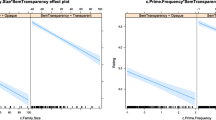Summary
Proceeding from the assumption that verbs imply their potential objects, an attempt was made to vary this implication by combining specific and general verbs (e.g. to adopt/to wash) with specific or general objects, respectively (e.g. boy/child). These 4 verb-object combinations were presented visually in simple subject-predicate-object sentences in a multitrial, free recall learning experiment. A highly significant interaction was found between verb and object variation. Specific verbs were better recalled when associated with general objects while general verbs were better recalled in association with specific objects.
Zusammenfassung
Ausgehend von der Annahme, daß Verben ihre möglichen Objekte bereits implizieren, wurde versucht, die Implikation für spezifische und allgemeine Verben dadurch zu variieren, daß sie mit jeweils einem spezifischen bzw. allgemeinen Objekt kombiniert wurden. Die 4 Verb-Objekt-Kombinationen wurden in einfachen Subjekt-Prädikat-Objekt-Sätzen in einem multitrial free recall Versuch optisch zum Lernen angeboten. Es zeigte sich eine hochsignifikante Wechselwirkung zwischen Verb- und Objektvariation. Spezifische Verben werden besser mit allgemeinen Objekten, allgemeine Verben besser mit spezifischen Objekten behalten.
Similar content being viewed by others
References
Anderson, R. C.: Semantic organisation and retrieval of information from sentences. J. Verb. Learn. Verb. Behav. 11, 794–800 (1972)
Chafe, W. L.: Meaning and the structure of language. Chicago: Univ. of Chicago Press 1970
Clark, H. H.: Word associations and linguistic theory. In: Lyons, J. (Ed.): New horizons in linguistics, pp. 271–286. Harmondsworth: Penguin Books 1970
Deese, J.: Psycholinguistics. Boston: Allyn and Bacon 1970
Engelkamp, J.: Semantische Struktur und die Verarbeitung von Sätzen. Bern: Huber 1973
Fillmore, C. J.: The case for case. In: Bach, E., Harms, R. T. (Eds.): Universals in linguistic theory, pp. 1–90. New York: Holt, Rinehart and Winston 1968
Geckeler, H.: Strukturelle Semantik und Wortfeldtheorie. München: Fink 1971
Greimas, A. J.: Strukturale Semantik. Braunschweig: Vieweg 1971
Johnson, N. F.: The psychological reality of phrase structure rules. J. Verb. Learn. Verb. Behav. 4, 469–475 (1965)
Katz, J. J., Fodor, J. A.: The structure of semantic theory. In: Fodor, J. A., Katz, J. J. (Eds.): The structure of language: Readings in the philosophy of language, pp. 479–518. Englewood Cliffs, N.J.: Prentice Hall 1964
Marshall, J. C.: Psychological linguistics: Psychological aspects of semantic structure. In: Meetham, A. R. (Ed.): Encyclopedia of linguistics, information, and control. London: Pergamon Press 1969
Marshall, J. C., Newcombe, F.: Syntactic and semantic errors in paralexia. Neuropsychologia 4, 169–176 (1967)
Meier, H.: Deutsche Sprachstatistik. Hildesheim: Olms 1964
Miller, G. A.: The magical number seven plus or minus two: Some limits on our capacity for processing information. Psychol. Rev. 63, 81–97 (1956)
Paivio, A.: Paired associate and free recall of nouns as a function of concreteness, specificity, imagery, and meaningfulness. Psychol. Rev. 20, 239–245 (1967)
Paivio, A., Yuille, J. C., Madigan, S. A.: Concreteness, imagery, and meaningfulness values for 925 nouns. J. exp. Psychol. 76 (Monogr. Suppl.), 1–25 (1968)
Perfetti, C. A.: Psychosemantics: Some cognitive aspects of structural meaning. Psychol. Bull. 78, 241–259 (1972)
Rips, L. J., Shoben, E. J., Smith, E. E.: Semantic distance and the verification of semantic relations. J. Verb. Learn. Verb. Behav. 12, 1–20 (1973)
Steinberg, D. D.: Analiticity, amphigory, and the semantic interpretention of sentences. J. Verb. Learn. Verb. Behav. 9, 37–51 (1970)
Author information
Authors and Affiliations
Additional information
The paper is based on an experiment conducted and evaluated by Anke Grashorn, as part of her diploma thesis, under the author's supervision.
Rights and permissions
About this article
Cite this article
Engelkamp, J. The interaction of semantic features of transitive verbs and their objects. Psychol. Res 37, 299–308 (1975). https://doi.org/10.1007/BF00309724
Received:
Issue Date:
DOI: https://doi.org/10.1007/BF00309724




